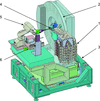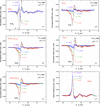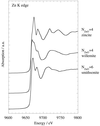issue contents
September 2008 issue

Cover illustration: View of the microspectrophotometer installed on beamline 10 at the SRS, Daresbury Laboratory (see Ellis, Buffey, Hough and Hasnain, pages 433-439), which allows optical spectroscopic, XAS and crystallographic data to be collected from the same crystal.
facility information
research papers
A newly designed 12-analyzer detector system for high-resolution powder diffraction has been installed at beamline 11-BM, a dedicated powder diffraction beamline, at the Advanced Photon Source. Initial characterization of the instrument is presented.
A single-crystal microspectrophotometer has been implemented on SRS beamline 10.1 providing a unique facility for combined crystallographic with on-line XAS-optical spectroscopic measurements from the same crystal. The need for such an approach is highlighted by data showing the rapid X-ray photoreduction of type-1 Cu centres.
The feasibility of X-ray magnetic circular dichroism to perform element-specific magnetometry by using a single X-ray absorption edge is demonstrated in the case of rare-earth transition-metal intermetallics.
The performance of an energy-dispersive CCD detector and its first application in a GISAXS experiment are described, and the potential of this kind of detector for future application is discussed.
Calculations are presented for the optimum wavelength to collect X-ray diffraction data from a small protein crystal of known dimensions. These calculations are compared with the possible benefits of using a short-pulsed X-ray source.
Methods for classifying Fe-bearing minerals according to features of their Fe K-edge XANES spectra are presented. These spectra are abstracted into two-dimensional plots in which various types of species, such as divalent or trivalent Fe oxides, fall into distinct regions.
An experimental approach to the analysis of charge, magnetic and orbital ordering in 3d transition-metal oxides is presented.
Various characteristics of a flat-panel detector are reported. Examples are given of its applications in a synchrotron light source.
A high-temperature furnace for spectroscopic studies of metals, alloys and other electrically conductive materials under extreme conditions is presented.
A solution of the problem of dynamical diffraction for X-ray pulses with arbitrary dimensions in the Bragg and Laue cases in a crystal of any thickness and asymmetry coefficient of reflection is presented. Analysis of pulse form and duration transformation in the process of diffraction and propagation in a vacuum is conducted. It is shown that only the symmetrical Bragg case can be used to avoid smearing of reflected pulses.
A first report of an X-ray absorption spectroscopy experiment at Synchrotron SOLEIL, part of a long-term study dedicated to pathological calcifications, is presented.
The opportunity to employ X-ray absorption near-edge spectroscopy techniques to investigate the alteration of the structural properties of sulfur in various vulcanized rubber sheets is presented.
The error on the absolute EXAFS mean-square relative displacements owing to the use of the Einstein-fit model has been estimated by means of dynamical simulations.
Bond-cutting of Alq3 by the doped K atoms occurs at high K concentration in a K-doped Alq3 layer.
Analyser-based computed tomography has been used to depict substructural variations within articular cartilage.
Fluorescent X-ray computed-tomography imaging with synchrotron radiation to detect the age-dependent metabolic abnormality in cardiomyopathy is reported.
short communications
Interstitial N2 gas contained within solid-state inorganic ammonium- and amine-containing salts can be used to quickly and accurately calibrate soft X-ray beamlines at the N K-edge without the need for gas-cell measurements.
computer programs
A new graphics program for the representation of constraint force vectors for small-angle X-ray scattering has been developed.
new commercial products
Free 

current events
Free 



 journal menu
journal menu













































